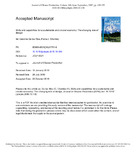JavaScript is disabled for your browser. Some features of this site may not work without it.
| dc.contributor.author | De los Rios, I.C. | |
| dc.contributor.author | Charnley, Fiona | |
| dc.date.accessioned | 2016-11-17T15:05:59Z | |
| dc.date.available | 2016-11-17T15:05:59Z | |
| dc.date.issued | 2016-10-24 | |
| dc.identifier.citation | De los Rios IC, Charnley FJ, Skills and capabilities for a sustainable and circular economy: The changing role of design, Journal of Cleaner Production, Volume 160, Issue September, 2017, pp. 109-122 | en_UK |
| dc.identifier.issn | 0959-6526 | |
| dc.identifier.uri | http://dx.doi.org/10.1016/j.jclepro.2016.10.130 | |
| dc.identifier.uri | http://dspace.lib.cranfield.ac.uk/handle/1826/10989 | |
| dc.description.abstract | Implementing practices for a circular economy transforms the way companies do business, notably in the manufacturing industry. However, a circular economy requires a transformation of both production and consumption systems; the standard approach for creation, fabrication, and commerce of products is challenged. Authors repeatedly call for the development of new proficiencies to attend to system transformations, but these so far have not been described for design and engineering. Given that the design of a product directly influences the way a value chain will be managed, building circular, globally sustainable value chains inevitably signifies a fundamental change in the practice of design. Comprehensive analyses were conducted on case studies from a variety of multinational enterprises that are transforming their product strategies for climate change. Changes in design processes were identified, revealing a growing necessity for industry to employ new proficiencies that support closure of material loops. This paper contributes to existing literature by depicting successful practices being implemented in industry. A variety of new capabilities are key to design for a sustainable future; these range from deeper knowledge of material composition to rich understanding of social behaviour. Resulting from this research, learning goals are proposed to serve as guidance for manufacturing companies seeking to tackle climate change. Conclusions aim to encourage researchers and academics to respond to emerging needs by re-thinking education in design and engineering. | en_UK |
| dc.language.iso | en | en_UK |
| dc.publisher | Elsevier | en_UK |
| dc.rights | Attribution-NonCommercial-NoDerivatives 4.0 International | |
| dc.rights.uri | http://creativecommons.org/licenses/by-nc-nd/4.0/ | |
| dc.subject | Circular economy | en_UK |
| dc.subject | Closed loop systems | en_UK |
| dc.subject | Design for lifecycle | en_UK |
| dc.subject | Sustainable strategy | en_UK |
| dc.subject | Sustainable product-service system (SPSS) | en_UK |
| dc.title | Skills and capabilities for a sustainable and circular economy: The changing role of design | en_UK |
| dc.type | Article | en_UK |
Files in this item
This item appears in the following Collection(s)
-
Staff publications (SWEE) [2825]

